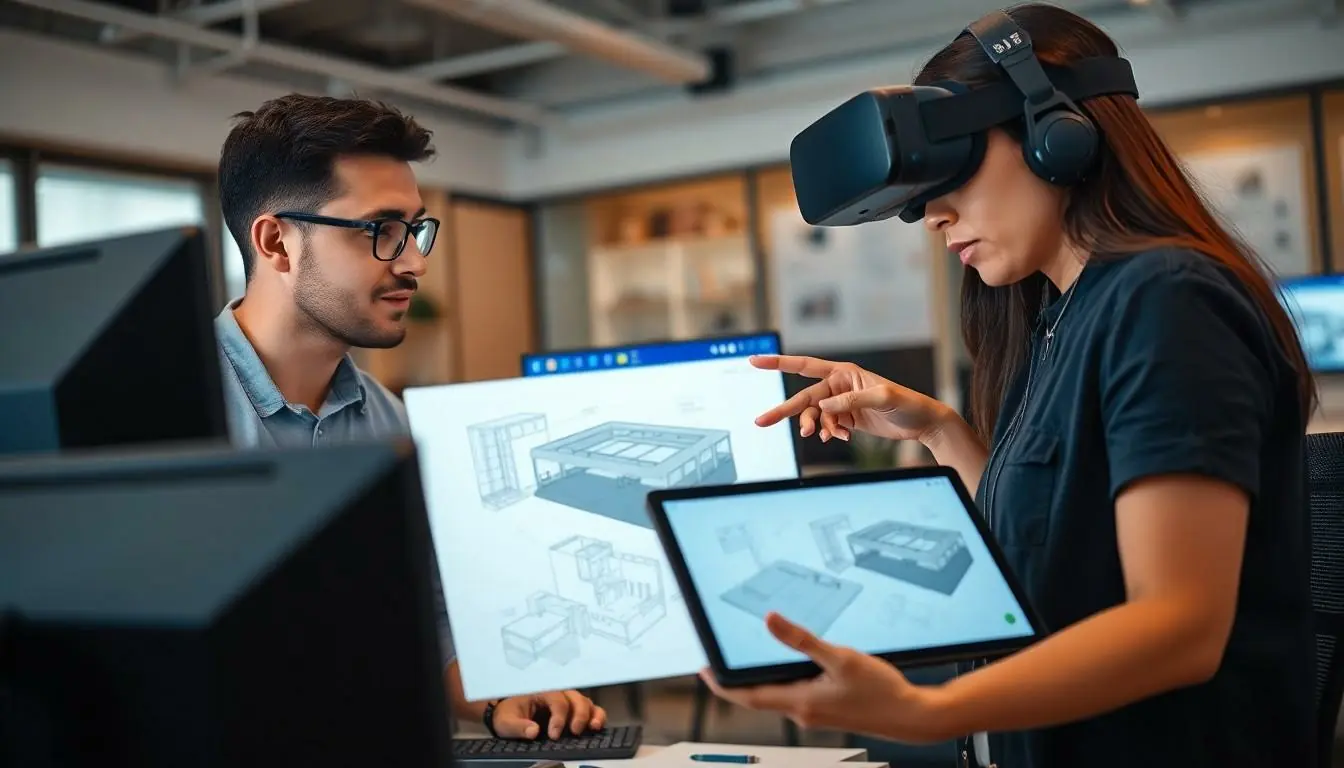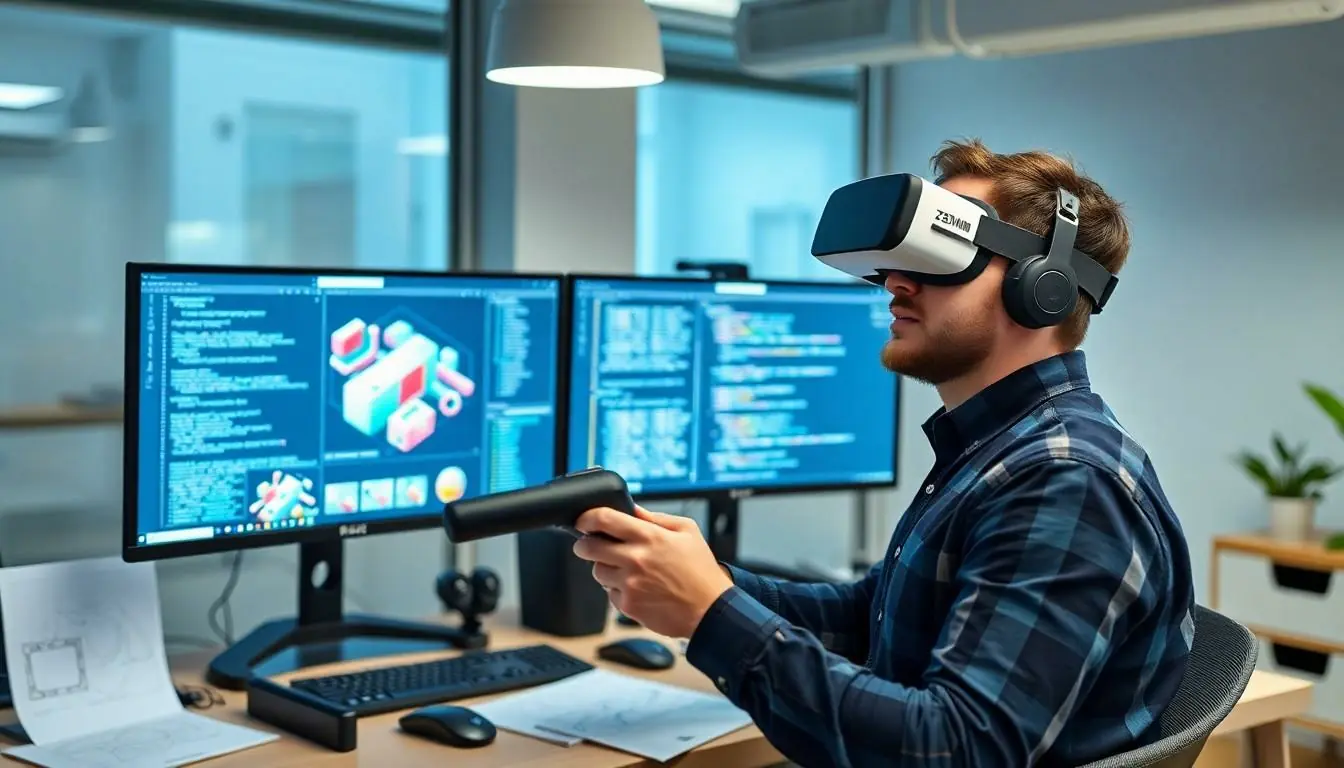In a world where reality gets a makeover and virtual adventures are just a headset away, the role of an AR/VR developer is nothing short of magical. These tech wizards blend creativity with cutting-edge technology to create immersive experiences that make users question what’s real and what’s not. Imagine stepping into a game or exploring distant lands without ever leaving your couch—sounds like a dream, right?
But let’s be honest. Being an AR/VR developer isn’t just about playing video games all day. It’s about crafting experiences that can transform industries, from entertainment to education. With the demand for these digital architects skyrocketing, it’s clear that the future is not just bright; it’s downright dazzling. So, if you’ve got a knack for coding and a flair for the fantastical, this might just be the career path that lets you unleash your inner genius.
Table of Contents
ToggleWhat Is an AR/VR Developer?
An AR/VR developer creates applications that deliver immersive experiences through augmented and virtual reality technologies. These developers work with tools such as Unity, Unreal Engine, and various programming languages, including C# and C++. Combining artistic vision with technical skills, they design interactive environments and simulations for multiple industries.
In entertainment, AR/VR developers craft games that engage users in new and exciting ways. They also explore educational applications, enabling students to visualize complex concepts through simulations. Medical training programs benefit from realistic patient scenarios developed by these professionals, enhancing learning experiences.
Skills in 3D modeling and animation are essential for AR/VR developers. Familiarity with software like Blender or Maya allows them to create realistic graphics. Problem-solving abilities play a crucial role, as they address technical challenges throughout the development process.
Communication skills enhance collaboration with designers, project managers, and clients. Often, AR/VR developers participate in brainstorming sessions to refine project concepts. Keeping up with industry trends and technological advancements is vital, ensuring they implement the latest features and functionalities.
Job opportunities exist across diverse sectors, including healthcare, education, gaming, and real estate. As demand for AR/VR solutions rises, these developers enjoy a solid career path. Fulfilling roles await those who embrace the fusion of creativity and technology in the AR/VR landscape.
Skills Required for AR/VR Development

AR/VR development demands a blend of technical and soft skills. These abilities ensure effective creation of immersive experiences and collaboration within teams.
Technical Skills
Proficiency in 3D modeling and animation software like Blender or Maya is essential. Knowledge of game engines, such as Unity or Unreal Engine, enables developers to create interactive environments. Familiarity with programming languages, particularly C# and C++, supports coding and scripting tasks. Understanding of AR/VR hardware and SDKs enhances the ability to develop for specific platforms. Experience with user interface and user experience design is valuable for creating intuitive interactions. Each technical skill contributes significantly to the overall success of AR/VR projects.
Soft Skills
Strong communication abilities facilitate dialogue between developers, designers, and clients. Problem-solving skills help tackle technical obstacles during development. Adaptability matters, as AR/VR technologies evolve rapidly. Teamwork plays a crucial role in collaborating effectively on projects. Creativity fuels innovation and inspires the design of unique experiences. Each soft skill enhances a developer’s capacity to contribute meaningfully in various industry settings.
Tools and Technologies Used in AR/VR Development
AR/VR development relies on various tools and technologies for creating immersive experiences. Knowledge of the right platforms and frameworks is essential for effective development.
Popular AR/VR Platforms
Unity stands out as a leading platform for both augmented and virtual reality development. Many developers prefer it due to its robust features and widespread support for various devices. Unreal Engine also garners attention for its high-quality graphics and advanced capabilities, making it suitable for complex projects. Other platforms like Vuforia and ARKit provide specific functionalities tailored to mobile AR applications. Developers frequently choose these platforms based on project requirements and target audiences.
Development Frameworks
Developers utilize several frameworks to streamline the AR/VR development process. A-Frame, based on HTML, simplifies the creation of virtual reality experiences directly in web browsers. React VR offers a familiar JavaScript framework for building VR applications within React. Similarly, AR.js enables fast AR experiences using only a few lines of code, optimizing performance on mobile devices. By selecting the appropriate framework, developers can enhance efficiency and creativity in their projects.
Career Opportunities for AR/VR Developers
The demand for AR/VR developers spans multiple industries, reflecting a significant growth trend. Healthcare relies on their expertise to create realistic simulations for training medical professionals. Education benefits as these developers craft interactive learning experiences that engage students effectively.
Gaming remains a primary sector, where developers create immersive worlds that captivate players. Developers also contribute to real estate by designing virtual property tours that enhance customer experiences. Many developers find opportunities in advertising, utilizing AR for creative marketing campaigns that attract consumer attention.
According to industry studies, the AR/VR market is expected to reach $300 billion by 2025, highlighting the potential career growth for developers. Positions often require a blend of technical skills and creativity, making it essential for candidates to adapt to new technologies. Freelancing offers flexibility and can lead to diverse projects, while companies increasingly seek full-time employees to maintain ongoing development.
Internships provide valuable experience and networking opportunities, helping aspiring developers establish connections in the industry. Job roles vary, including AR/VR software developers, 3D artists, and user experience designers. Staying updated with industry trends and tools, such as Unity and Unreal Engine, empowers developers to remain competitive in this evolving field.
Career progression commonly includes senior developer roles or leadership positions in project management. Continuous learning and skill enhancement enable developers to transition into different sectors, maximizing their impact on innovative AR/VR projects. Employers value collaboration, so joining a community or attending conferences fosters growth and knowledge exchange.
Challenges Faced by AR/VR Developers
AR/VR developers encounter multiple challenges while creating immersive experiences. One significant hurdle pertains to technology limitations. Current hardware often restricts the level of detail and realism achievable in virtual environments. Developers must optimize applications to work smoothly across various devices, ensuring consistent performance.
Another challenge involves user experience design. Crafting intuitive interfaces can prove difficult, especially when dealing with diverse target audiences. Understanding user behavior and preferences is vital for creating engaging interactions. Each design decision impacts how users perceive and engage with the virtual world.
Moreover, content creation poses its own set of obstacles. Developers frequently need to balance creativity and technical constraints. Ensuring that 3D models and animations render well without compromising performance can be a complex process. Additionally, high production costs related to advanced graphics and immersive sound design can strain budgets.
Collaboration plays an essential role in overcoming these challenges. Developers often work alongside designers, project managers, and clients, necessitating effective communication. Misunderstandings can lead to delays or misaligned expectations, directly impacting project timelines.
Staying updated with industry trends adds pressure to the development process. Rapid technological advancements require developers to continuously learn and adapt. Taking the time to familiarize oneself with new tools and software is crucial for maintaining a competitive edge.
Lastly, addressing accessibility concerns remains a priority. Developers strive to ensure that applications are usable by individuals with varying abilities. Creating inclusive experiences broadens the audience and enhances overall engagement.
AR/VR developers must navigate these challenges to succeed in the dynamic landscape of immersive technology. With proper strategies, they can transform obstacles into opportunities for innovation and enhanced user experiences.
The future of AR/VR development holds immense promise for those eager to blend creativity with technology. As industries continue to explore the potential of immersive experiences the demand for skilled developers will only increase. With opportunities spanning entertainment healthcare and education this field offers a dynamic career path.
Developers who embrace continuous learning and collaboration will find themselves well-equipped to tackle challenges and innovate. By staying updated with the latest trends and tools they can enhance their skill set and contribute to groundbreaking projects. The journey in AR/VR development is not just about creating engaging content but also about shaping the future of how people interact with technology.

